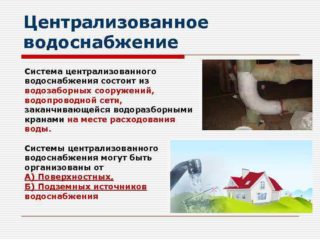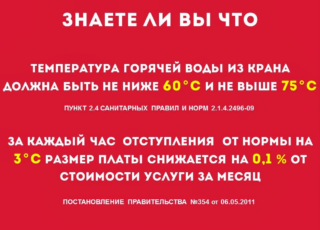The centralized water supply system is a complex network that provides the population with hot and cold water. It is constantly being improved and modernized, acquiring new technical parameters.
Definition and scope
Centralized water supply is hot and cold. Mostly it operates in cities, large cottage villages. In some cases, water pipes are supplied to industrial buildings located within the boundaries of settlements.
Regulatory Requirements
When organizing central water supply, state regulatory requirements for the arrangement of external networks (SNiP 2.04.02-84) and internal water supply of buildings (2.04.01-85) must be observed. These documents regulate the design of the system, the features of the placement and the characteristics of its structural elements.
Regulatory requirements regarding the quality of water used for household and drinking purposes are specified in SanPiN 2.1.4.1074-01, GOST 2874-82. The documents also prescribe the rules for exercising control over its characteristics. The standards are mandatory for legal entities, entrepreneurs whose activities are related to the design, construction and operation of centralized water supply.
Characteristics and types of sources
- Control the presence of hazardous contaminants. This rule especially applies to lakes where there is no natural flow.
- When choosing surface sources, water intake structures are placed on a section of a river with a stable channel. This prevents their destruction.
- The fence is organized above the mouth of the tributaries flowing into the river. This approach reduces the likelihood of additional contaminants entering the source.
- The equipped system must ensure the uninterrupted supply of resources in the required volume.
Surface sources include rivers, lakes, artificial reservoirs and reservoirs with a depth of at least 2.5 m. They are divided into channel, bucket, and coastal. For artificial sources, the depth of the fence should be as large as possible. This will produce water with optimum performance. At great depths, there is no blooming effect. Also, there is no fence from the highly mineralized layer, which is usually located closer to the surface.
Hydrological systems located in the upper layers of the earth's crust are chosen as underground sources. These are groundwaters, artesian wells, and upper waters. The water intake is organized at a minimum distance from the settlement, the possibility of expansion is provided with an increase in water consumption. This scheme has many advantages - high water quality and constancy of its parameters.
When using underground sources, boreholes are usually equipped.They are hundreds of meters deep, which makes it possible to simultaneously exploit several horizons. The well is a circular shaft. Its walls are made of a metal pipe, which makes it impossible to destroy them. To ensure the required volume of water intake, several wells are usually equipped.
System design
The groundwater
When using underground sources, the system includes:
- wells;
- first lift pumps - move water into a special underground reservoir;
- pumps of the second lift - pump out the contents of the tanks and move it to the distribution network;
- filter - designed to trap large particles in the aquifer;
- water tank.
Horizontal water intakes consist of a receiving and a discharge part. In the latter, unauthorized diversion of water into a well and a pumping station is observed.
When using sources in the form of open springs, capturing devices are used. Water enters the chamber, without fail passing through the filter. It is also protected from the penetration of contaminants from the outside. The intake takes place from the bottom or an opening in the wall of the capturing chamber.
Surface sources
- water intake facilities;
- devices used to improve the quality of mined resources;
- distribution network.
When taking water from open reservoirs, there is a special receiver. It is equipped in the form of a shore well or a bucket. The rise of water to the treatment plant is carried out using pumps.
Connection conditions
To use centralized water supply for household and drinking purposes, you must apply to the appropriate authorities (local Vodokanal). At the request of the consumer, the institution provides technical specifications.
Vodokanal employees develop schemes for connecting to the main pipeline, indicate the location and depth of the water pipelines. Based on the obtained technical conditions, specialists will equip all the necessary units from the distribution well to metering devices.
Differences between hot and cold centralized water supply
Cold water supply complies with the following standards:
- provides consumers with a resource around the clock throughout the year;
- in the absence of hot water supply, water heating can be carried out using water heaters;
- the maximum duration of the anhydrous period is 8 hours per month (excluding emergencies).
For DHW, there are requirements for the water temperature. It cannot deviate from the standard by more than 3-5 ° C. Cutting off the water in the event of an emergency lasts no longer than 24 hours.
Advantages and disadvantages
The advantages of centralized water supply include:
- 24/7 access to an unlimited water source;
- maintenance of networks is carried out by specialized services without involving the consumer in the process;
- high quality of supplied resources.
The disadvantages of the system include the need for constant control over the volumes of resource consumption, on the basis of which payment is made. Often there is a need for additional purification of water from rust and chlorine.













